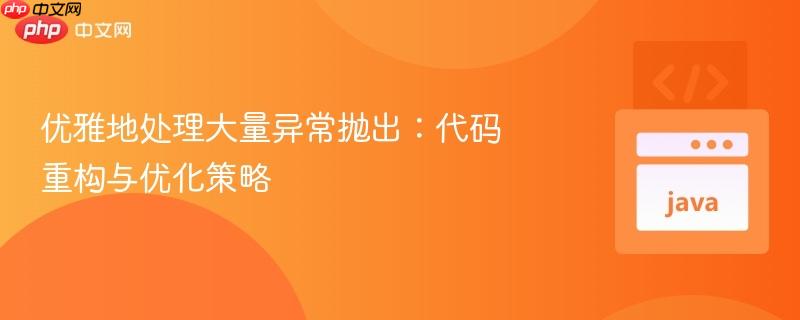
本文针对函数内部存在大量异常抛出导致代码臃肿、可读性差的问题,提供了一种通过提取异常检查逻辑到单独函数中,并统一处理异常的重构方案。该方案旨在简化主函数逻辑,提高代码的可维护性和可读性,并提供示例代码进行演示。
在软件开发过程中,我们经常会遇到需要在函数内部进行大量条件判断并抛出异常的情况。如果这些条件判断逻辑复杂且分散,会导致代码变得冗长、难以阅读和维护。本文将介绍一种通过重构来优化这种情况的方法,旨在提高代码的整洁性和可读性。
假设我们有一个函数 problematicFunction,它接收多个参数,并在函数内部对这些参数进行各种逻辑判断,如果判断不满足条件,则抛出相应的异常。原始代码可能如下所示:
public void problematicFunction(String string1, String string2, String string3, String string4) throws GenericException {
if(string1.someLogicHere()) {
throw new GenericException("error_code", "something is wrong with " + string1);
}
if(string2.someLogicHere()) {
throw new GenericException("error_code", "something is wrong with " + string2);
}
if(string2.someOtherLogicHere()) {
throw new GenericException("error_code", "something else is wrong with " + string2);
}
if(string3.someLogicHere()) {
throw new GenericException("error_code", "something is wrong with " + string3);
}
if(string4.someLogicHere()) {
throw new GenericException("error_code", "something is wrong with " + string4);
}
mainLogic(string1, string2, string3, string4);
}可以看到,大量的 if 语句和 throw 语句占据了函数的大部分代码,使得主逻辑 mainLogic 被淹没在异常处理的细节中。
为了解决这个问题,我们可以将异常检查的逻辑提取到一个单独的函数中,该函数负责检查所有可能抛出异常的条件,并返回相应的错误信息。然后,在原始函数中,我们只需要调用这个函数,并根据返回值来决定是否抛出异常。
以下是重构后的代码示例:
public class Example {
String checkExceptions(String string1, String string2, String string3, String string4) {
if (string1 != null && string1.length() > 5) return string1;
if (string2 != null && string2.startsWith("test")) return string2;
if (string3 != null && string3.contains(" ")) return string3;
if (string4 != null && string4.equalsIgnoreCase("null")) return string4;
return null; // or create some NoException String
}
public void problematicFunction(String string1, String string2, String string3, String string4) throws GenericException {
String checkExcp = checkExceptions(string1, string2, string3, string4);
if (checkExcp != null) {
throw new GenericException("error_code", "something is wrong with " + checkExcp);
}
// main logic
mainLogic(string1, string2, string3, string4);
}
private void mainLogic(String string1, String string2, String string3, String string4) {
// Your main logic here
System.out.println("Main logic executed successfully!");
}
public static void main(String[] args) {
Example example = new Example();
try {
example.problematicFunction("valid", "valid", "valid", "valid");
example.problematicFunction("toolongstring", "valid", "valid", "valid");
} catch (GenericException e) {
System.err.println("Exception caught: " + e.getMessage());
}
}
}在这个示例中,checkExceptions 函数负责检查所有的异常条件,并返回第一个触发异常的参数。如果没有任何异常触发,则返回 null。在 problematicFunction 函数中,我们首先调用 checkExceptions 函数,如果返回值为非空,则抛出异常。否则,执行主逻辑 mainLogic。
通过将异常检查逻辑提取到单独的函数中,我们可以有效地解决函数内部存在大量异常抛出导致代码臃肿、可读性差的问题。这种重构方法可以提高代码的可读性、可维护性和可复用性,从而提高软件开发的效率和质量。在实际开发中,我们应该根据具体情况灵活运用这种方法,以达到最佳的优化效果.
以上就是优雅地处理大量异常抛出:代码重构与优化策略的详细内容,更多请关注php中文网其它相关文章!

每个人都需要一台速度更快、更稳定的 PC。随着时间的推移,垃圾文件、旧注册表数据和不必要的后台进程会占用资源并降低性能。幸运的是,许多工具可以让 Windows 保持平稳运行。

Copyright 2014-2025 https://www.php.cn/ All Rights Reserved | php.cn | 湘ICP备2023035733号